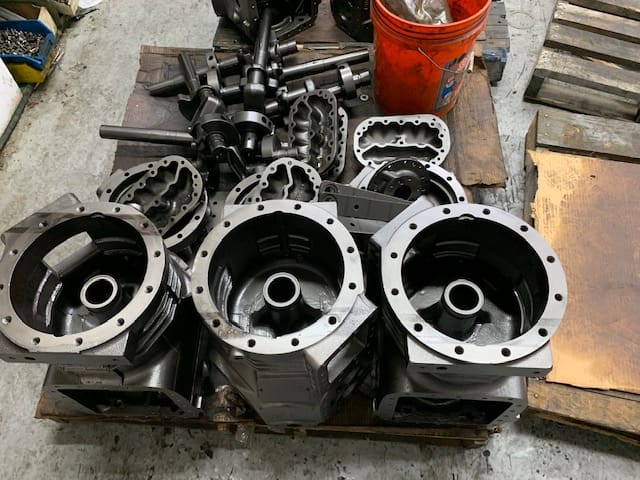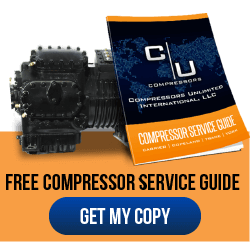 How can you accurately identify a new or remanufactured compressor straight out of the box? The answer is: you most likely can’t, unless you are a commercial compressor repair expert.
How can you accurately identify a new or remanufactured compressor straight out of the box? The answer is: you most likely can’t, unless you are a commercial compressor repair expert.
There are three primary categories of commercial compressors: new, remanufactured, and rebuilt compressors.
Understanding the difference between these categories will help you know the type of compressor that will suit your needs. However, you can’t merely tell the quality or performance of a compressor simply by looking.
What is a Remanufactured Compressor?
Remanufactured is an industrial process that involves the reconstruction of a compressor to bring it to a previous or improved condition. The remanufactured compressors at Compressors Unlimited either meet or exceed OEM specs.
In remanufacturing, a unit is disassembled and the worn-out pieces are replaced with new or usable refurbished ones.
How is a Remanufactured Compressor Different from a New Compressor?
When it comes to remanufacturing compressors, there are strict industry standards that must be met.
For example, the unit has to meet, or even surpass, all the functional qualifications of a 100% new OEM compressor. This means that while a remanufactured unit may have a previously used part, no worn-out parts will be used since industry regulations require worn-out parts to be replaced with new or remanufactured ones.
The compressor should also meet the standard requirements of a brand new compressor, making it just as good as a new one.
New compressors are assembled with all brand-new parts and casings. Some of these items are still made by OEMs but are hardly ever used for service replacement due to their high-end price tags. The high cost of a new commercial compressor makes most companies choose less costly alternatives. This is why most replacement units available on the market are “remanufactured” options.
There is generally no huge discrepancies in terms of performance between a new and remanufactured compressor. The only thing that separates these two compressors is simply the label “new” and “remanufactured” and of courese cost.
How Does a Remanufactured Compressor Compare to a Rebuilt Unit?
You can also go for rebuilt compressors. Many people associate rebuilt units with remanufactured ones. However, these two compressors are not similar at all.
The rebuilding process does not adhere to strict manufacturer’s specifications for new compressors, while the remanufacturing process adheres to these guidelines. In the assembling process of a rebuilt compressor, old, and even worn-out, components are used to make the compressor provided they are in working condition. These salvaged parts are usually at different stages of their operational lifespan.
In many rebuilt compressors, only the issue that caused the compressor to fail is addressed in the rebuild processs. Rebuilt compressors are not routinely assembled based on established quality standards. Therefore, they are often inferior and undoubtedly incomparable to remanufactured compressors in terms of performance.
The Remanufacturing Process of Commercial Compressors
The demand for superior quality commercial compressors in today’s market necessitates rigorous remanufacturing guidelines that meet industry standards. Here are the steps followed in the remanufacturing process of commercial compressors:
- The first step is the disposal of the oil that is being held in the compressor. Once the compressor is drained, it is taken apart to bare casting for a thorough inspection. The castings are then scrutinized for deficiencies. The castings that don’t meet industry criteria are disposed of, while those in good condition are cleaned using environmentally friendly methods and returned to bare metal or iron castings.
- Next, the crankcases are inspected to see whether they meet the set limits. Special consideration is paid to the surfaces of the crankshaft neck and threaded holes.
- Many vital components, such as piston rings, inserts, discharge valves, and bearings, are never reused or refurbished for future use. Instead, the parts are replaced with new components. Valve plates are either replaced with new ones or remanufactured, functional ones to guarantee excellent valve seating. New springs and reeds are reassembled with the valves as well.
- The pistons, crankshaft, liners, and rods are polished and assessed to see whether they are within current OEM limits. Components that fall below specified tolerances are discarded and replaced.
- Proper seating of new rings depends on the condition of a cylinder. Therefore, the cylinder holes are first assessed for physical defects. From there, the casings are examined and re-honed as par the OEM guidelines.
- During motor upgrades, stators undergo electronic testing. Stators that are not functioning properly are repaired under controlled temperatures, polished, and retested. Also, since power loads occur frequently, rotors are generally subjected to surge tests to gauge their performance in start-up overloads.
- Oil pumps are rigorously examined, updated, reassembled, and tested to ensure compliance with oil flow and pressure guidelines.
- The remanufacturing process is finalized by reassembling the compressors and fitting all components according to the manufacturers’ specifications. After that, the compressors are sealed using bank-off plates, nitrogen-charged, tested for leakages and then run tested. The units are not cleared to be added to inventory or sold to any customer until they pass all the tests.
Today, many compressor remanufacturers, including Compressors Unlimited, choose to follow the stipulations of the International Compressor Remanufacturers Association for quality control. Get your commercial compressor from a remanufacturer that adheres to industry standards like that of Compressors Unlimited to ensure you are getting a quality remanufactured compressor.












